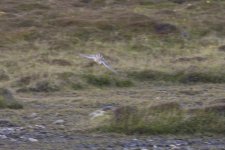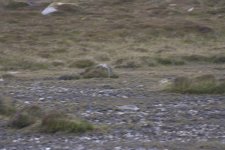Pluvius
Well-known member
I saw this bird with another birder on Tory Island and our first impressions were Great Snipe (I have never seen one) Up to ten years ago I had spent nearly thirty years rough shooting and am very familiar with snipe.
This bird was flushed and made no noise but flew about a metre off the ground for about forty metres. It looked almost as big as a woodcock. It flew straight and its wingbeat was far slower than snipe. We both simultaneously said is that a Great Snipe.
To me it seemed to have very white outer tail feathers. We looked for it initially unsuccessfully and then flushed it again where I got this fairly out of focus shot. Again it flew low away from us before disappearing.
This bird was flushed and made no noise but flew about a metre off the ground for about forty metres. It looked almost as big as a woodcock. It flew straight and its wingbeat was far slower than snipe. We both simultaneously said is that a Great Snipe.
To me it seemed to have very white outer tail feathers. We looked for it initially unsuccessfully and then flushed it again where I got this fairly out of focus shot. Again it flew low away from us before disappearing.







